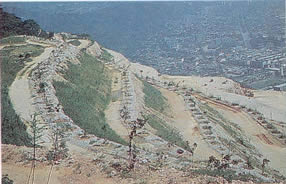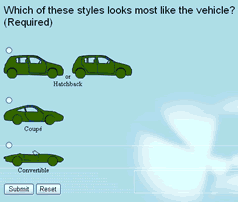|
Researchers use KnowledgeWright
to Develop Advanced Expert Systems
KnowledgeWright is the tool of choice for a number of academic researchers
to deliver a wide range of projects from undergraduate to advanced degrees.
These projects illustrate the flexibility and power of the KnowledgeWright
architecture.
Protecting Slopes from Erosion
 Jorge
Chou is a Masters student at the National Central University in Taiwan.
He developed an expert system to provide advice about how to protect slopes
from erosion or other damage from construction. Jorge starting working
with KnowledgeWright while it was in beta test. He worked closely with
Amzi! to allow the user's interactions with the knowledgebase to be in
Chinese, and he was able to edit and debug the rules all in Chinese. Although
he searched the Web for several months, KnowledgeWright was the only product
that providing him with the ability to build and deploy a system entirely
in his native language. Jorge
Chou is a Masters student at the National Central University in Taiwan.
He developed an expert system to provide advice about how to protect slopes
from erosion or other damage from construction. Jorge starting working
with KnowledgeWright while it was in beta test. He worked closely with
Amzi! to allow the user's interactions with the knowledgebase to be in
Chinese, and he was able to edit and debug the rules all in Chinese. Although
he searched the Web for several months, KnowledgeWright was the only product
that providing him with the ability to build and deploy a system entirely
in his native language.
Jorge's website uses a combination of tools to support his web-based
expert system. He uses JSP and KnowledgeWright's ready-to-run Web interface
to host the knowledgebase. It was important to Jorge to use tools off-the-shelf,
so that instead of spending time developing the user interface, he could
focus his efforts on coding his expertise into the knowledgebase. He uses
KnowledgeWright's Web interface which does all the work of interacting
with the user for him. Jorge's knowledgebase has HTML tags in the text
to provide the formatting he requires. The knowledgebase asks the user
about the slope that needs to be protected and the conditions under which
such protection is to be provided. It uses pictures such as the one here
to illustrate methods to protect the slope.

Identifying Cars
Richard Benson is a BSc student at the University of Surrey in the U.K.
His project for the "Intelligent Systems" course was to build
an expert system to identify a car based on whatever parts of the car
a user has seen (e.g. doors, grill, lights, bumpers). The knowledgebase
displays pictures for most of the questions so the user does not need
to know about cars in general or models in particular. Also, the user
can answer "I don't know" to any of the detailed questions.
 The
system was built to run under IIS and uses an Access database to store
the characteristics of the cars. The knowledgebase reasons over SQL queries
(using ODBC) to identify the car. The database includes 470 car models
built by Ford during the last six years. The
system was built to run under IIS and uses an Access database to store
the characteristics of the cars. The knowledgebase reasons over SQL queries
(using ODBC) to identify the car. The database includes 470 car models
built by Ford during the last six years.
Richard chose KnowledgeWright for a number of reasons, the most significant
of which was the extensive and easy to follow tutorials. These tutorials
were unsurpassed by other tutorials he tried with other products that
left him with little or no understanding of how to approach the shell
to make it do what he needed it to do. KnowledgeWright was easy-to-use;
especially when debugging his knowledgebase. The log screen let him see
exactly what values have been inferred and which facts have been found.
Also KnowledgeWright's ready-to-run Web runtime gave him an easy way to
create a user interface as he had a very limited understanding of programming,
but a good knowledge of HTML. The Web runtime allowed Richard to make
his knowledgebase look good, and allowed him to use images within the
questions to aid the users decisions. Without this runtime, Richard would
only have been able to demonstrate his knowledgebase from within the KnowledgeWright
Workshop, thus making it inaccessible to anyone without a copy of the
Workshop.
This was the first knowledgebase Richard had built and thanks to KnowledgeWright
he found it a lot easier than he expected. He also believes he has just
begun to scratch the surface of KnowledgeWright's potential, and in the
hands of an experienced knowledgebase engineer it would be an incredibly
powerful tool.
|

